How Machine Learning Tracks Pest Behavior
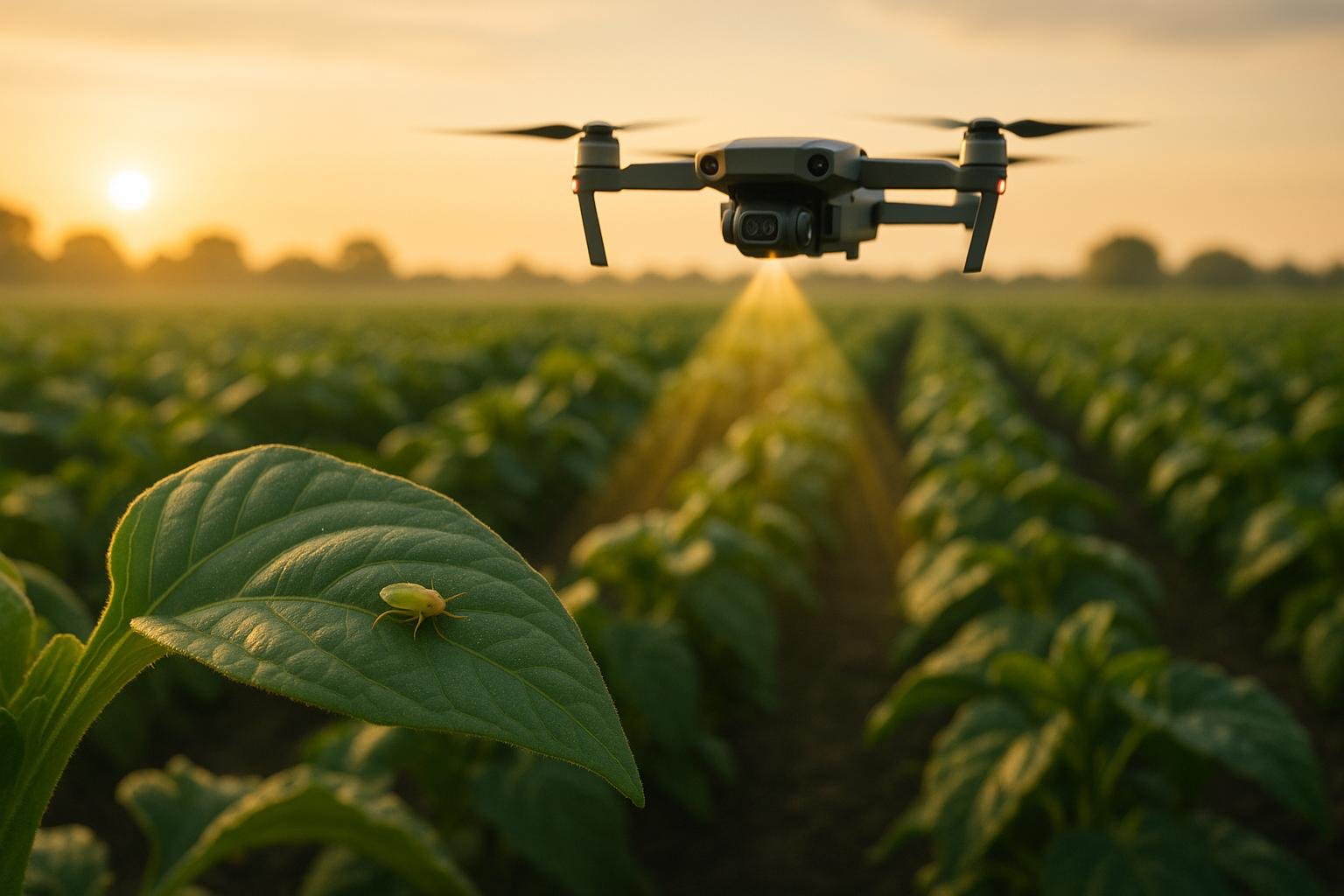
Machine learning is changing how we manage pests by using data to predict, detect, and prevent infestations. Here's what you need to know:
- Early Detection: AI-powered tools identify pests before they cause damage, using sensors, cameras, and environmental data.
- Precision: Smart sprayers and traps reduce pesticide use by up to 90%, saving costs and protecting crops.
- Real-Time Monitoring: Systems like IoT-enabled traps and predictive models provide 24/7 updates and alerts.
- Cost Savings: AI reduces water, fertilizer, and pesticide expenses, saving farmers and gardeners up to 15% on operations.
- Challenges: High upfront costs, technical complexity, and the need for quality data are barriers to adoption.
Quick Tip: Start with simple tools like AI-powered apps or smart traps, then scale up as you learn. Machine learning offers a smarter, more efficient way to protect plants while reducing environmental impact.
AI in agriculture 010: Melon Fruit Fly Pest Detection

Machine Learning Methods for Tracking Pests
Machine learning has revolutionized how we track and identify pests in gardens and agricultural fields. From basic pattern recognition to advanced systems capable of predicting pest behavior, these technologies are becoming increasingly accurate and practical.
Image Recognition for Pest Detection
At the heart of modern pest detection lies Convolutional Neural Networks (CNNs). These deep learning models excel at processing images, identifying the most distinctive features of insects, and delivering far better accuracy than older methods.
For instance, the GoogleNet CNN achieved an impressive 93.78% accuracy in controlled tests. Similarly, researchers at Kumaraguru College of Technology developed a real-time pest detection system using the EfficientNetB7 architecture. This system not only achieved 93.5% classification accuracy but was also successfully implemented on an STM32 microcontroller for precision agriculture.
Mobile apps have made these technologies even more accessible. A team led by Prabha created an Android app that uses deep CNNs to identify pests in maize crops. Image segmentation techniques also play a key role in enhancing detection accuracy by reducing background noise. For example, Lu and Ye used GrabCut and SVM methods to detect pests like Locusta migratoria manilensis and Oedaleus decorus asiaticus, achieving 96.16% detection accuracy. These advancements are paving the way for systems that integrate additional environmental data, making pest outbreak predictions even more reliable.
Predicting Pest Outbreaks with Data Analysis
Machine learning isn't just about detection - it’s also about prevention. By analyzing environmental factors like air temperature, humidity, dew point, and CO₂ levels alongside historical pest data, these models can predict infestations before they escalate. In fact, one deep learning model using these variables achieved an average AUROC of 0.917, enabling proactive pest management.
On a larger scale, satellite imagery and meteorological data are combined with IoT sensor feeds to create dynamic prediction systems. These systems analyze historical pest and disease records to anticipate threats in real time. According to the Food and Agriculture Organization, pests cause up to 40% of global crop losses annually, costing the economy $290 billion. With advancements in big data and deep learning, such predictive tools are becoming increasingly practical, especially for facility farms equipped with environmental sensors.
Using Labeled Datasets to Train Models
The effectiveness of machine learning models hinges on high-quality labeled datasets. These datasets require careful image collection, precise annotation, and preprocessing to ensure accurate learning. For models to perform well in real-world scenarios, diverse datasets are essential.
Data augmentation techniques like rotations, flips, zooms, and brightness adjustments are often applied to expand datasets and reduce the risk of overfitting. This ensures that models can recognize pests under varying conditions, such as different lighting or angles commonly found in gardens.
Transfer learning has also emerged as a game-changer. By using pre-trained models, researchers can achieve high performance even with smaller, specialized datasets. The EfficientNetB7 architecture, for example, uses compound scaling to balance computational efficiency and accuracy, making it highly effective for pest classification.
Deep learning models have consistently delivered outstanding results, often exceeding 95% accuracy and 90% precision in detection tasks. One study reported 98.17% accuracy in identifying crop pests in real agricultural settings using CNNs. Publicly available datasets like IP102 provide standardized resources for training and validation, ensuring fair comparisons between different approaches.
Pests are responsible for destroying up to 40% of global crops each year, with invasive insects alone causing losses of approximately $70 billion. These statistics highlight the critical role of well-trained machine learning models in safeguarding food supplies and supporting both individual gardeners and global agriculture.
How Machine Learning Tracks Pest Behavior: Step-by-Step Process
Machine learning systems for tracking pest behavior follow a structured process, creating an efficient monitoring system that can detect, analyze, and respond to pest activity in real time. Here’s how it works:
Collecting Data with Sensors and Cameras
Everything begins with gathering accurate and detailed data. Advanced systems use sensors and cameras to capture environmental conditions and pest behavior.
Take Trapview by EFOS Ltd., for example. This system employs IoT-enabled insect traps with cameras and sensors to monitor pest populations in orchards and vineyards. The traps photograph captured insects, building a visual database for AI systems to analyze.
Environmental sensors are essential here. They track factors like soil moisture, temperature, humidity, and light - conditions that heavily influence pest activities. Devices like the Xiaomi Soil Moisture Sensor help identify overwatering, which can attract pests like slugs and fungus gnats. Similarly, the ThermoPro TP67 Digital Hygrometer monitors humidity levels that encourage aphid reproduction or fungal growth.
Motion detection technology adds another layer. For instance, the Orbit Yard Enforcer uses infrared sensors to detect movement and activate deterrents. Specialized cameras capture video footage of pest activity, offering visual data for machine learning systems to process.
Systems like FarmSense go even further by combining insect and environmental data collection in the field and sending it to the cloud for AI analysis. Similarly, the Anticimex SMART Digital Rodent Control System uses digital traps and sensors to track rodent activity, creating trend curves to predict population changes.
Once the data is collected, the next step involves teaching the machine learning models to make sense of it.
Training Machine Learning Models
Before models can analyze pest behavior, they need to be trained. This starts with preprocessing the data to ensure it’s usable. Techniques like rotations, flips, zooms, and brightness adjustments help expand datasets, while more advanced methods like Autoencoders and Generative Adversarial Networks (GANs) are used to deal with limited data and improve model reliability.
Transfer learning has revolutionized pest detection. Instead of building models from scratch, researchers adapt pre-trained models like EfficientNet to identify pests. For example, researchers at the University of California used predictive modeling to forecast outbreaks of the Western grape leafhopper by analyzing weather data and historical infestation trends. This approach helps farmers take proactive measures to prevent damage.
Evaluating model performance is key. Metrics like accuracy, precision, recall, and F1-score are used to measure effectiveness. For instance, Chen et al. developed a smartphone app to detect scale pests using object detection models like Faster R-CNN, SSD, and YOLO v4. Among these, YOLO v4 achieved the highest accuracy. YOLO models have shown a 94% average detection accuracy in mango orchards and maize fields, while the EfficientNetB7 model reached 93.5% classification accuracy through transfer learning. Balancing datasets to include all pest species equally is also vital to avoid bias toward more common pests.
Once the models are trained and fine-tuned, they can be deployed for real-time monitoring.
Real-Time Monitoring and Alert Systems
The final step is deploying these trained models to monitor pests and trigger responses as needed. These systems continuously analyze incoming data and act immediately when a threat is identified.
For example, Rentokil's PestConnect system provides 24/7 monitoring, offering immediate pest control and detailed reports on pest trends and recommendations. AI-powered pheromone traps have also helped cotton farmers manage bollworms by optimizing pesticide application, reducing overuse, and improving crop yields.
Alerts can trigger various responses. The Victor Smart Kill Bug Zapper, for instance, resets automatically after each capture, while more advanced systems send smartphone notifications with pest details and suggested actions. Blue River Technology's smart sprayer showcases precision by cutting herbicide use by up to 90% compared to traditional methods.
Even during the alert phase, environmental monitoring continues. Smartphone-controlled watering systems regulate moisture levels to deter pests, while ultrasonic devices like Pestbye emit high-frequency sounds to protect plants. Combining motion sensors with automated traps creates a robust pest defense network. These real-time systems are especially valuable in sensitive areas like food storage, where timely alerts can prevent significant losses.
sbb-itb-4d6a8dd
🚀 Ready to Reinvent Your Garden?
Join thousands of homeowners who have transformed their gardens using our AI design tool. Upload one photo to explore endless possibilities.
Get your AI garden designs →Pros and Cons of Machine Learning for Pest Management
This section dives into the advantages and challenges of using machine learning in pest management, building on the detection and prediction methods discussed earlier. While machine learning offers some clear perks in pest control, it also comes with its own set of hurdles.
Key Benefits of Machine Learning in Pest Control
One of the standout benefits of machine learning is its ability to detect pest threats early - before they cause visible damage. This early detection can stop infestations before they even start.
Another major advantage is precision. Take Bowery Farming in the U.S., for example. They collect an impressive 30,000 data points per cycle, which has helped them achieve 100 times the productivity per square foot while using 95% less water.
Reducing chemical pesticide use is another win. Smart sprayers, for instance, can cut herbicide use by up to 90% compared to traditional broadcast methods. Similarly, The Wine Farm in Australia adopted machine learning–based models to predict diseases, which reduced fungicide use by 30% while maintaining high-quality grapes.
Cost savings are a big draw, too. AI-powered irrigation systems can reduce water use by 20–30%, while optimized fertilizer application can lower fertilizer costs by 15–25%. On top of that, targeted pesticide spraying can cut pesticide expenses by 10–20%. Altogether, large farming operations could see operational cost savings of 10–15%.
Machine learning also provides constant, 24/7 monitoring, giving you peace of mind without the need for continuous human supervision. Matej Štefančič, CEO of Trapview, highlights this advantage:
"We've built the biggest database of pictures of insects in the world, which allows us to really use modern AI-based computing vision most optimally."
Challenges and Limitations
Despite its benefits, machine learning comes with some obstacles. The upfront cost is one of the biggest barriers - sensors, drones, and AI-powered equipment can be expensive, making it tough for smaller operations to afford.
Then there’s the learning curve. Many gardeners and farmers may not have the technical know-how to use these advanced tools effectively. This makes accessible training programs crucial for understanding how to implement AI-based pest management.
The quality of data is another sticking point. Machine learning relies heavily on consistent and accurate data. Poor-quality data can lead to incorrect predictions and ineffective pest control measures.
Integrating machine learning with existing equipment can also be tricky. Older machinery may not be compatible with new AI solutions, adding another layer of complexity. And while automation reduces manual labor, human oversight is still needed to verify predictions and correct errors.
Finally, the market for ready-to-use AI pest control systems is still limited. Custom solutions are often expensive and may not be practical for everyone.
Comparison Table: Benefits vs Drawbacks
| Aspect | Benefits | Drawbacks |
|---|---|---|
| Detection | Early detection prevents infestations | Requires high-quality data for accuracy |
| Precision | Targeted treatments reduce chemical use significantly | Algorithms can sometimes produce biased results |
| Cost | Saves 10–15% on operations, cuts fertilizer costs 15–25% | High upfront investment in equipment and training |
| Monitoring | 24/7 automated surveillance and alerts | Expensive setup and ongoing technical support needed |
| Labor | Reduces manual inspection work | Human oversight still required for validation |
| Environmental Impact | Cuts environmental footprint by about 35% on average | Integration with older systems can be challenging |
Ultimately, deciding whether to adopt machine learning for pest management depends on factors like your budget, the size of your operation, and your comfort with technology. Starting small with simpler, budget-friendly solutions and scaling up as you gain experience can be a smart approach.
Adding Machine Learning Tools to Smart Garden Systems
Smart garden systems are stepping into the future by incorporating machine learning tools for real-time pest management. With the market for smart gardening tools expected to exceed $3.2 billion by 2025, there’s never been a better time to enhance your garden setup with these advanced technologies. The good news? You don’t need to start from scratch - you can build on your existing system and gradually introduce pest management features.
Connecting Machine Learning with Garden Technology
Modern smart garden setups thrive when technologies work together seamlessly. If you already use smart irrigation or weather monitoring tools, integrating machine learning for pest detection can transform your garden into a well-coordinated system that addresses multiple challenges.
By using your current sensors and cameras, you can power machine learning algorithms to detect pests. These devices gather data on heat, movement, and sound, which the algorithms analyze to identify pest activity. The key is to choose sensors that work with your existing equipment, avoiding the need for a complete overhaul.
Smart traps equipped with IoT technology add another layer of efficiency. These traps send real-time alerts to your smartphone when pests are detected, allowing you to combine automated detection with manual verification. This integration enhances pest detection while laying the groundwork for a more comprehensive garden management approach.
For example, Semios’s precision farming platform successfully reduced moth populations in almond orchards by 1.5 billion, demonstrating the power of machine learning in pest control. Additionally, AI-powered smart sprayers can cut herbicide use by as much as 90%, and smart irrigation systems can reduce water waste by up to 50%.
Some systems even sync with smart home ecosystems, enabling you to control pest management through voice commands or monitor everything from a single app. This unified approach simplifies tracking both pest activity and overall garden health.
Using AIGardenPlanner for Complete Garden Solutions
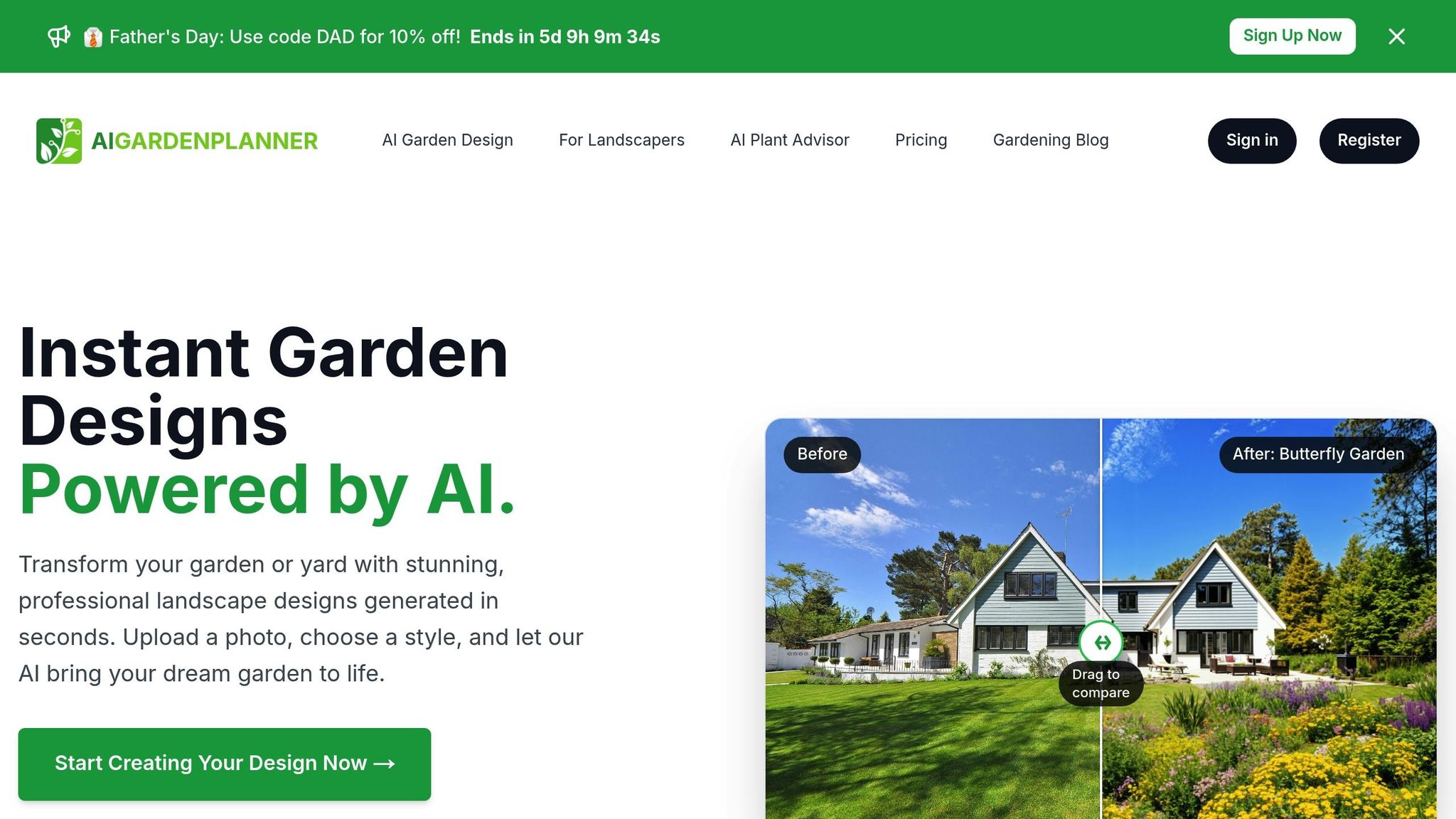
AIGardenPlanner, while primarily focused on garden design and plant recommendations, pairs perfectly with machine learning pest management tools. Its AI Plant Advisor offers personalized recommendations based on your location, climate, and preferences, helping you select plants that are naturally more resistant to local pests.
This connection between plant selection and pest management is critical. When you upload a photo of your garden to AIGardenPlanner, the platform not only provides design suggestions from over 50 garden styles but also recommends plants suited to your specific environment. Choosing pest-resistant plants complements the proactive pest control enabled by machine learning.
The platform’s detailed growing guides include maintenance schedules that can sync with your pest monitoring system. For instance, if your AI pest detection tools identify increased aphid activity during a plant’s growth phase, you can align treatments with the guide’s care schedule for maximum effectiveness.
AIGardenPlanner’s location-based recommendations are especially useful. For example, a plant suggestion for a Texas garden will address different pest challenges than one tailored for Minnesota, helping you build natural resistance into your garden from the outset.
Practical Tips for U.S. Gardeners
Once you’ve integrated design and pest management tools, a few practical tips can help ensure your garden thrives. Start small by adding a few devices and scale up as needed. This gradual approach keeps costs manageable and gives you time to learn how the tools work together.
Monitor temperatures carefully, as pest activity often aligns with specific temperature ranges. Many common pests become active between 70°F and 85°F, so set your sensors to alert you when conditions are ideal for pest emergence.
For soil monitoring, combine machine learning with traditional methods. Smart sensors track moisture and soil temperature, while AI analyzes this data to predict pest cycles. This is particularly helpful in regions with unpredictable spring weather, where soil conditions can trigger pest outbreaks.
Invest in equipment with good customer support, regular software updates, and solid warranties. Machine learning tools require updates to maintain accuracy, so reliable support is essential.
Budget-conscious gardeners can take inspiration from systems like Kishan Know, which was recognized at Intel’s AI Global Impact Festival in 2021. Developed by students at VIT-Chennai Campus, this low-cost system uses thermal imaging to detect pest or bacterial attacks for less than $1 per analysis. It’s a great example of how accessible machine learning pest detection can be.
To maximize effectiveness, combine tech tools with traditional gardening practices. Select pest-resistant plants, maintain proper spacing, clean up debris regularly, and use companion planting. These practices boost the success of machine learning systems by creating a healthier garden environment.
If you prefer a hands-off approach, consider subscription-based monitoring services. These services handle the complex algorithms for you, offering cloud-based analysis of your sensor data while still delivering the benefits of machine learning.
Integration takes time, so start simple. Focus on basic monitoring during peak pest seasons - typically late spring through early fall in most U.S. regions. As you gain confidence with the technology, you can expand your system to include automated treatments and predictive modeling. By blending machine learning with smart gardening practices, you’ll create a thriving, pest-resistant garden.
Conclusion: Using Machine Learning for Better Pest Control
Machine learning is reshaping pest control by shifting from reactive methods to proactive, data-driven strategies that save time, money, and resources. By analyzing complex patterns from sensors, cameras, and environmental data, it equips gardeners with a level of control that was previously unimaginable.
Key Points for Gardeners and Landscapers
Unlike traditional methods that rely on manual monitoring, machine learning offers precision and consistency. Manual pest scouting often suffers from human error and variability, while machine learning provides reliable and scalable solutions.
The benefits extend beyond accuracy. Smart sprayers, for example, can cut herbicide use by up to 90%, while AI-powered irrigation systems reduce water consumption by up to 50%. Tools designed for plant identification now achieve over 90% accuracy in recognizing species.
For gardeners looking to adopt these technologies, starting with AI-powered apps is a practical first step. From there, they can expand to include sensor networks as needs grow. Platforms like AIGardenPlanner offer tailored plant recommendations, enhancing the effectiveness of these technologies and adding extra layers of protection to gardens.
With these tools already showing promise, the future of smart gardening holds even more exciting possibilities.
The Future of Smart Gardening with Machine Learning
As machine learning becomes more integrated into pest control, emerging technologies are set to revolutionize gardening further. Combining Internet of Things (IoT) sensors with cloud-based AI allows for faster and more accurate pest predictions as datasets grow. This means even small-scale gardeners will gain access to advanced pest prediction tools typically reserved for large-scale operations.
"AI is poised to transform pest control on all fronts. It automates tasks, so owners and field technicians have more time to focus on strategic growth. It improves customer experience through better communication and more effective service. Those results lead to increased revenue through more new appointments and repeat business." - Dylan Henryson, Market General Manager, Pest, FieldRoutes
Future technologies like AI-equipped robotic systems are being developed to navigate gardens, identify pest problems, and take action autonomously. Blockchain integration could also play a role by creating transparent tracking systems for pesticide applications, encouraging more responsible use.
Predictive capabilities are advancing rapidly. Current deep learning models can already predict pest and disease risks with impressive accuracy - achieving an average AUROC of 0.917 in testing. These systems could evolve to not only predict risks but also simulate environmental adjustments to mitigate them.
This technological evolution complements traditional gardening knowledge rather than replacing it. For U.S. gardeners, these advancements promise practical, cost-effective solutions as technology becomes more accessible. Machine learning enhances hands-on experience by offering data-driven insights, creating a powerful partnership between innovation and time-tested gardening practices. The future of pest control lies in this synergy, where technology and tradition work together to optimize garden management.
FAQs
What are some cost-effective ways for small-scale farmers to use machine learning for pest management?
Small-scale farmers can now tap into machine learning for pest management without stretching their budgets by taking advantage of smart, cost-conscious strategies. One approach is collaborative purchasing, where groups of farmers pool resources to share the cost of AI tools. This way, advanced technologies become more accessible without the hefty individual price tag. Another practical option is to start small - beginning with limited, phased implementations - and gradually expand as the benefits and savings become clear.
To further ease the financial burden, programs like the USDA's Microloan Program are available. These loans provide up to $50,000 in funding and are tailored to small and mid-sized farms. With a simplified application process, they make it easier for farmers to invest in new technologies and improve pest management practices without unnecessary hassle.
What sensors and data are essential for using machine learning to monitor pest behavior?
To keep tabs on pest behavior using machine learning, three main tools come into play: cameras, acoustic sensors, and environmental sensors. Cameras gather visual data, capturing details like pest movement and activity patterns. Acoustic sensors pick up the sounds pests make, offering another layer of detection. Meanwhile, environmental sensors track factors like temperature and humidity - conditions that can significantly impact pest behavior.
Once this data is collected, machine learning algorithms step in to analyze it. These algorithms can identify specific pests, forecast potential outbreaks, and deliver real-time updates. With this information, gardeners can take timely, informed actions to tackle infestations and better safeguard their plants.
How does machine learning make pest detection more accurate and efficient than traditional methods?
Machine learning is transforming pest detection by automating tasks that used to rely heavily on manual effort - and often came with a high margin of error. Instead of depending on human observation, which can be inconsistent and time-intensive, machine learning algorithms process vast amounts of data - like images and environmental factors - to pinpoint pests with impressive accuracy.
These systems identify pests by recognizing distinct visual patterns, allowing gardeners and farmers to act quickly and limit pesticide use. They can even predict pest outbreaks by analyzing past trends and environmental data, enabling proactive planning. This approach not only conserves time and resources but also reduces crop losses, making pest management smarter and more efficient.
🎨 Visualize Your Dream Garden Today!
Transform any outdoor space into a professional landscape design in minutes. Just upload a photo, choose your style, and let our AI do the rest.
Start your garden transformation now →Related posts
Related Articles
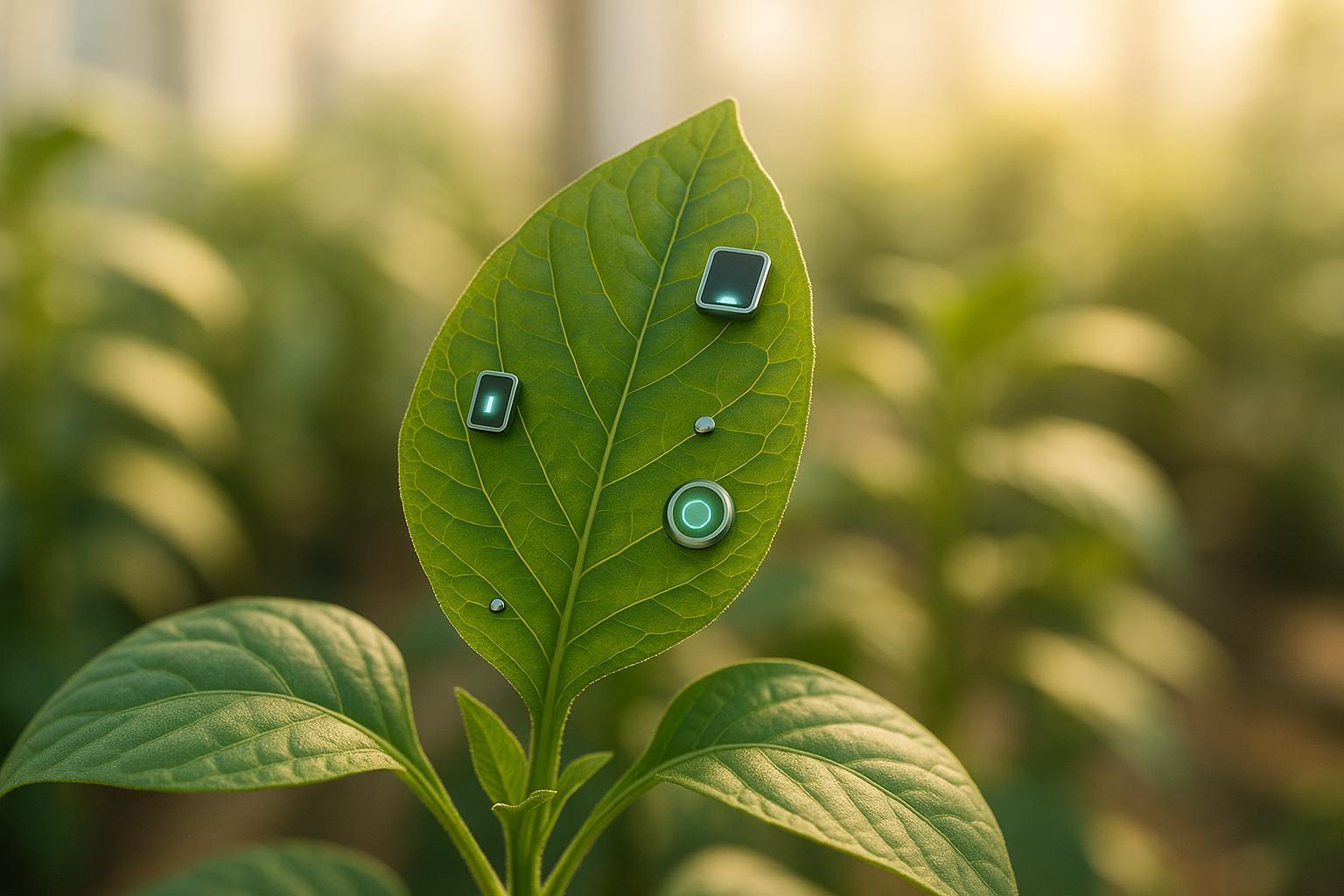
How Multi-Sensor Systems Detect Plant Diseases
Explore how multi-sensor systems revolutionize plant disease detection with advanced technology, offering early insights and precise treatment strategies.

Natural Wood Treatments for Sustainable Garden Design
Explore eco-friendly wood treatments for gardens, from tung oil to milk paint, and find the best options for your sustainable garden design.

AI Climate Analysis for Plant Selection
Explore how AI is revolutionizing gardening by providing tailored plant recommendations based on local climate and conditions, ensuring resilient gardens.

Backyard Vegetable Garden Ideas: A Guide to Designing and Planting
Learn how to design and plant a backyard vegetable garden that will yield a bountiful harvest. This guide covers the benefits of growing your own vegetables, factors to consider before starting, types of crops to plant, and maintenance tips.
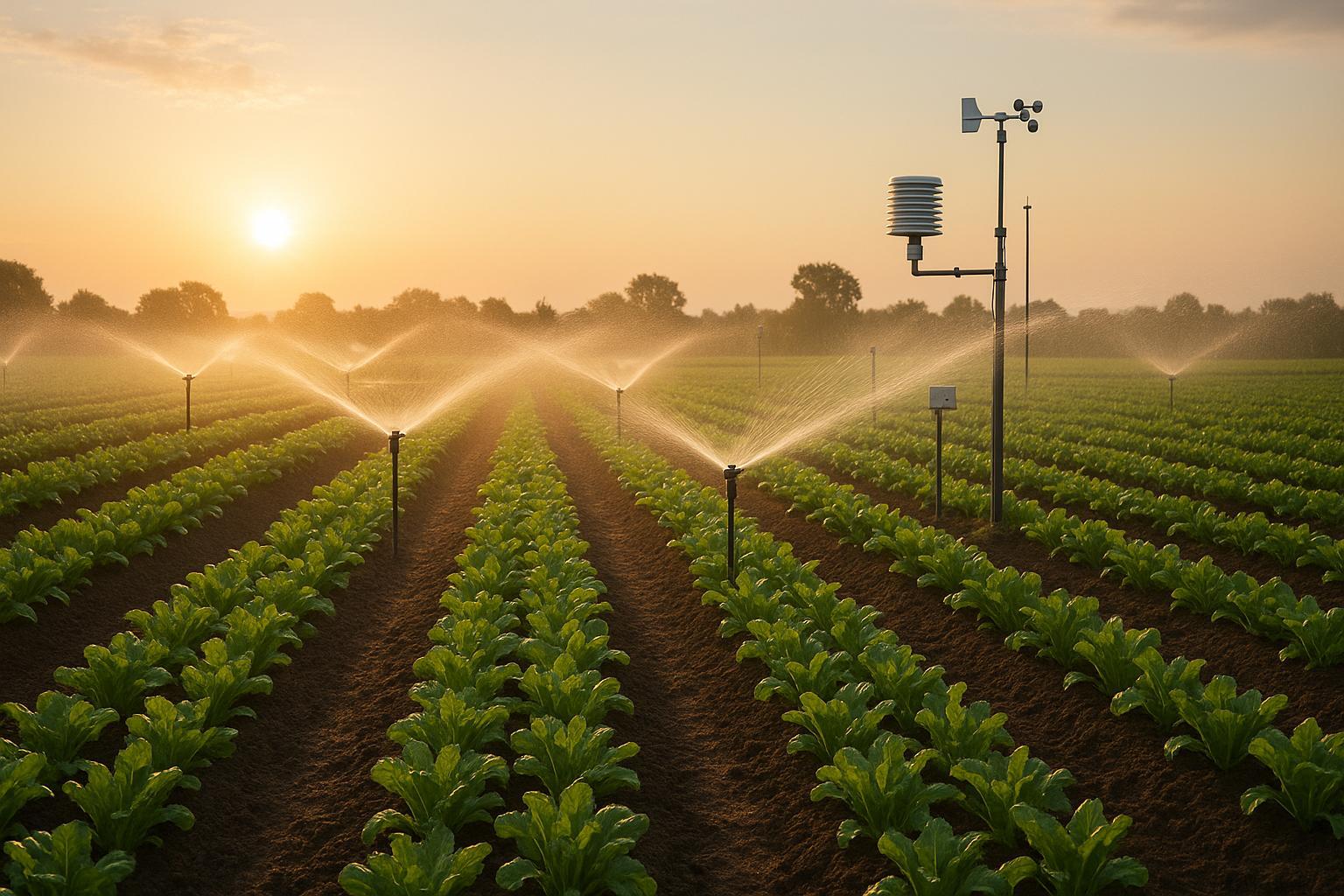
How Dynamic Irrigation Adapts to Real-Time Data
Dynamic irrigation systems utilize real-time data to optimize water use, enhance plant health, and reduce costs in gardening and agriculture.
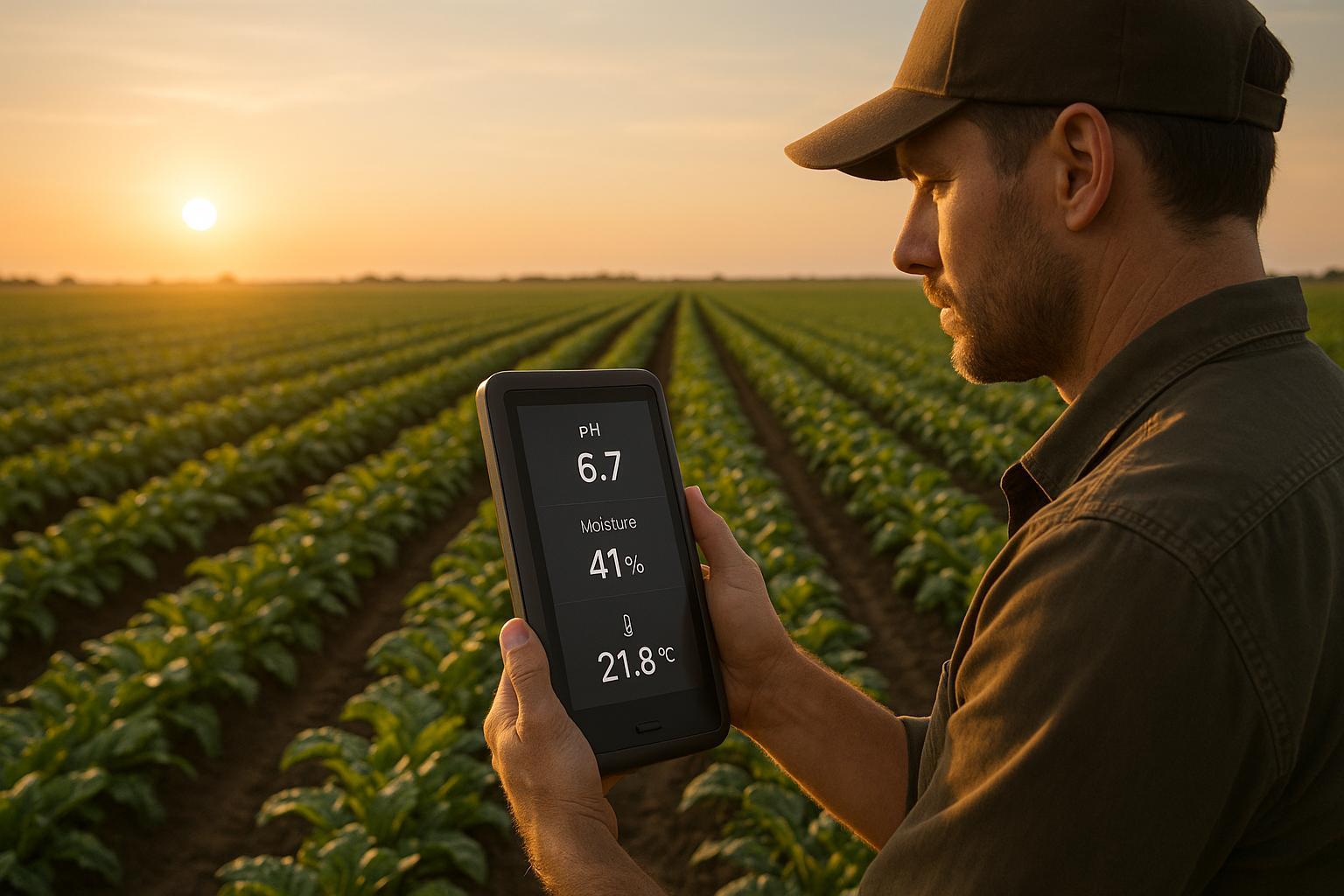
How Calibration Impacts Monitoring Accuracy
Effective calibration of monitoring tools is essential for accurate data, reducing pesticide use, and ensuring healthy crop management.